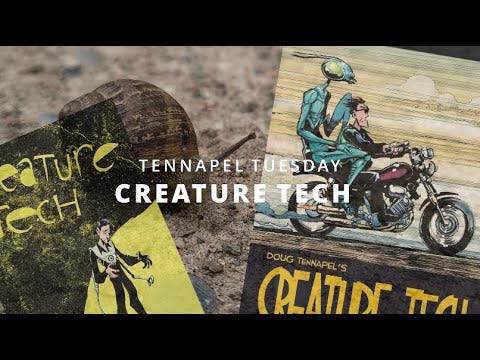TenNapel flashback: What made "Creature Tech" a movie in ink?
Here's tmatt's forward to the Image edition of this classic graphic novel
The whole process of moving from one house to another is so, so tedious and even painful.
This is especially true for journalism pack rats of a certain age who — for professional reasons (mixed with some paranoia) — have a tendency to avoid throwing away ANYTHING that might be useful in future research and writing.
After all, that thick file of handwritten notes from interviews with a legendary figure will be important when it’s time to write a farewell tribute (such as “Tesser well, Madeleine L'Engle”). And what about tapes from the era before smartphone recording programs? Did I mention that a box containing all the interview cassettes from my journalism career was submerged, during the recent historic floods, in water and mud in the cellar of our new Northeast Tennessee home?
All the boxes are packed with memories. The same thing is true with the rows of loaded bookshelves, especially when we’re talking about the home of a librarian and a journalist/professor.
This brings me to an interesting book that I unpacked the other day in my home office — the updated Image edition of “Creature Tech,” the classic graphic novel by Doug TenNapel. I wrote the forward for that edition and I thought Rational Sheep readers would enjoy seeing that text.
Why? I think parts of it are relevant during the ongoing discussions of what people of faith could be doing, or should be doing, in an age when the Internet niches (think streaming channels, in particular) are changing the shape of Hollywood and the entertainment industry as a whole.
So here we go. Yes, I added some relevant URLs to the mix.
You are in a movie theater.
Suddenly, a giant shark rises out of a silent sea. In shock, a man retreats into the boat's cabin and quietly mentions the need for a bigger boat.
An archetypal villain dressed in black armor clenches his fist at a wounded young man and proclaims, "I am your father."
A giant broadsword is thrown, slowly tumbling, against a blue-gray sky and then lands, thrust into a Scottish battlefield with its handle pointing toward heaven -- the hilt forming a cross in honor of a fallen hero.
The shower curtain is jerked to one side. A woman raises her hands in defense. A knife rises, then falls. The woman's mouth freezes in a screen. She clutches the curtain and falls, the curtain rings popping off in rapid fire. Blood swirls in the water as it rushes down the drain.
A custodian tosses a child's sled into a fireplace to burn with other objects discarded from a man's rich, tumultuous life. The flames lick at its name -- Rosebud.
There are moments in movies that lock into the viewer's mind as singular images. The film itself rushes on, of course, in waves of imagery, music, sound effects and dialogue. But the frozen image remains, as if wrapped in an unseen mental frame. In hindsight, it is easy to imagine an artist sitting at his easel, using a pencil or a pen to create that singular image that will frame this moment as it comes to viewers through a camera lens.
Then the artist draws another image, aiming the momentum of the movie toward another establishing shot, another ink-and-paper map to lead the director and cinematographer to the next crucial frame, the next symbolic image. The action and imagery continue between these frozen moments, but it's clear that the visual storytellers are swinging like trapeze artists between these tent poles in the imagination.
Keep reading with a 7-day free trial
Subscribe to Terry Mattingly -- Rational Sheep to keep reading this post and get 7 days of free access to the full post archives.




